Player Amenities: Essential Features & Modern Upgrades for Pro Athletes
Updated On: October 24, 2025 by Aaron Connolly
Core Player Amenities
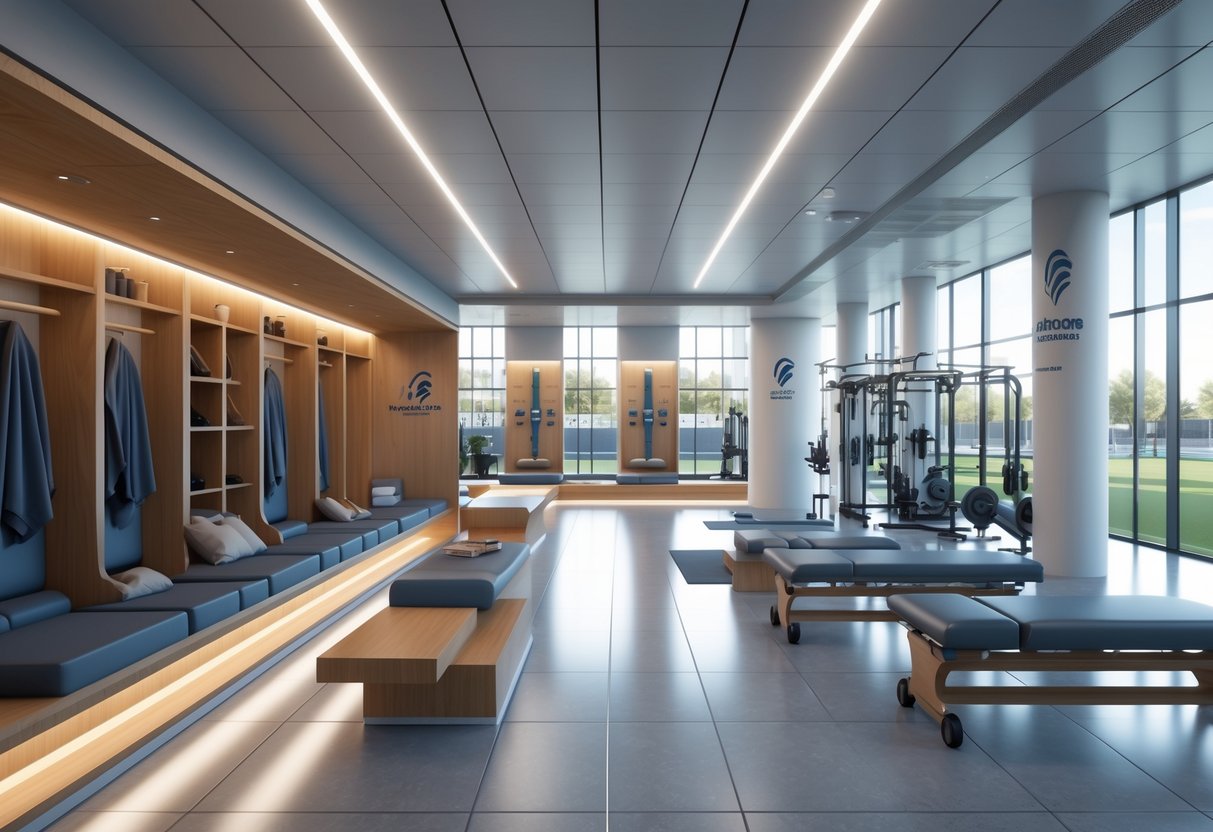
Every great esports venue starts with the basics. Core player amenities let athletes get ready, stay focused, and keep their gear safe while they compete.
Private Changing Rooms
Players really appreciate private changing rooms before matches. Esports events usually mean uniforms or sponsor gear, so having a quiet spot to change makes a difference.
Crowd noise and chatter from other teams easily break concentration. Soundproofing helps a lot. Most venues give each team their own room with comfy seating.
Key features include:
- Individual lockers for every player
- Mirrors for those last-minute checks
- Decent lighting so you can actually see
- Climate control to keep things comfortable
The best venues throw in charging stations for phones or headsets. Some even add mini fridges for energy drinks or snacks. Teams and coaches should fit in comfortably.
Comfortable Showers and Toilets
After hours of gaming, players need proper showers. Tournament days can stretch 8-12 hours, and stress levels get high. A hot shower between matches does wonders.
Players want hot water, good pressure, and clean towels—not just a basic rinse-off. Ventilation matters too, otherwise the place gets muggy fast.
Toilets should sit close to the gaming areas. Every minute counts during those short breaks.
Essential requirements:
- Hot water around the clock during events
- Non-slip floors for safety
- Good privacy locks
- Frequent cleaning
Secure Personal Storage
Players don’t travel light. They bring custom keyboards, mice, headsets—sometimes worth thousands. Secure storage isn’t optional.
Individual lockers beat shared spaces every time. Each player gets a lockable spot, and venues add cameras plus restricted access for peace of mind.
Professional venues provide:
- Full-size lockers for big equipment
- Small compartments for valuables
- 24-hour security monitoring
- Insurance for stored items
Some venues put charging ports inside lockers, so backup gear charges overnight. Refrigerated storage is handy for meds or contact lens solutions.
Digital locks with unique codes top the list. No lost keys, and staff can swap codes between events in seconds.
Players Lounge
Players lounges give gamers a place to unwind between matches. These spaces mix comfort, entertainment, and a bit of social time.
Lounge Design and Comfort
Modern lounges aim for a cozy, homey vibe. You’ll see sectional sofas, recliners, sometimes even custom theatre seats.
Some players prefer to chill alone, others hang out in groups. Bean bags and floor cushions work well for the younger crowd.
Temperature control is a must. Lighting varies—some spots are bright for reading, others dim for movie-watching.
Key comfort features:
- Ergonomic seating for long sessions
- Quiet zones for naps or downtime
- Personal storage cubbies
- Phone charging stations
Sound dampening makes a big difference, especially when the gaming area gets loud. It’s nice to have a peaceful spot to decompress.
Private booths or pods give players space for calls or one-on-one talks with coaches.
Entertainment Options
Players need a break from competition. Big-screen TVs show tournaments, movies, or just regular TV.
Console gaming setups let players relax with single-player or party games. Sometimes you’ll find old-school arcade machines too.
Popular entertainment choices:
- Streaming services (Netflix, Disney+)
- Tournament broadcasts
- Music streaming
- Board and card games
Some lounges add retro gaming systems for a nostalgia kick.
Reading nooks with gaming mags, guides, or even regular books give players a screen break.
Virtual reality stations pop up in some venues, offering fitness games or just fun exploration.
Food and Beverage Stations
Nutrition stations serve healthy meals and snacks. Some lounges have bars for hot meals or quick bites.
Typical food offerings:
- Fresh fruit and veggies
- Protein bars and shakes
- Sandwiches and wraps
- Hot meals during training camps
Drink stations offer filtered water and sports drinks. At night, many venues skip high-caffeine energy drinks.
Players store their own food in refrigerated areas, so they can stick to their preferred diet and save a bit of cash.
Coffee machines and tea stations are pretty common. Gentler caffeine, less jittery than energy drinks.
Communal tables bring teams together for meals. Food stays away from expensive gear thanks to separate eating spots.
Nutrition and Dining Facilities
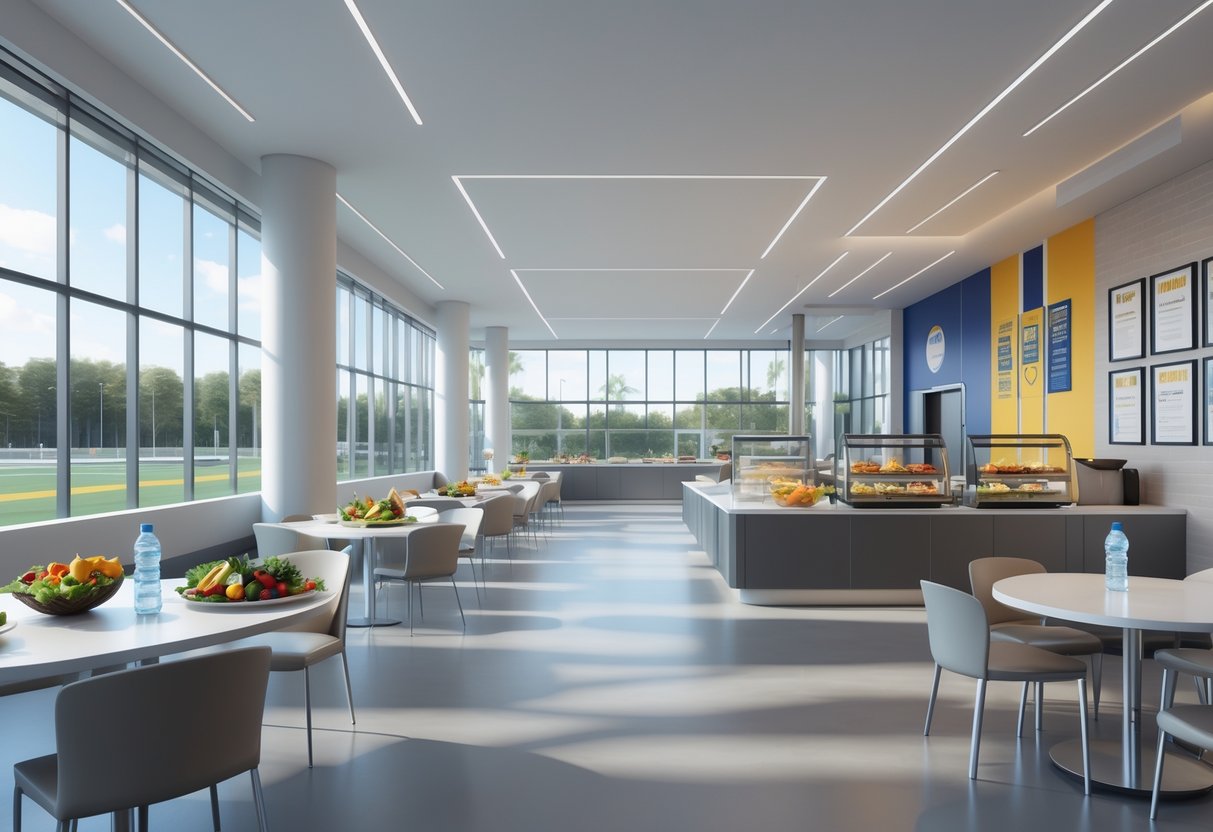
Good nutrition fuels top performance. Modern football programmes put a lot of thought into dining spaces and nutrition stations to help players train and recover.
Wellness-Focused Meal Options
Now, football programmes run full dining halls with breakfast, lunch, and dinner designed for athletes. Certified nutritionists and performance chefs work together on meal plans that target recovery and on-pitch performance.
It’s not just cafeteria food. Many facilities have full kitchens, plus hot and cold storage to keep meals fresh. Places like Clemson’s PAW Bistro can feed up to 300 people at once.
Key nutritional focuses include:
- High-protein meals for muscle recovery
- Complex carbs for lasting energy
- Anti-inflammatory foods to help prevent injuries
- Hydration support with plenty of drink options
Dining halls often double as event spaces on match days. Universities sometimes turn these areas into hospitality spots for fans, which brings in extra revenue while keeping nutrition a priority.
On-Site Nutrition Stations
Nutrition bars sit right in training facilities, so players can grab fuel before or after a workout. You’ll find energy bars, protein shakes, fruit, and trail mix all within reach.
Some programmes use pass-through fridges for things like Gatorade, smoothies, or recovery drinks.
Equipment often includes:
- Vitamix blenders for custom smoothies
- Granita machines for protein drinks
- Three-shelf displays for bars and snacks
- Refrigerated units for anything perishable
Coaches can quickly give personalised nutrition support. Players with dietary needs or specific training goals get tailored foods and supplements.
Dedicated Player Dining Areas
Exclusive dining spaces—separate from the regular student crowd—let teams focus on nutrition and bonding. Amenities here boost the dining experience and support performance.
Most halls have big TVs for team meetings or educational content. Climate control keeps food safe, and flexible seating works for meals or meetings.
Standard amenities feature:
- Room for 200-300 athletes
- Multiple drink stations and coolers
- Flexible seating for all sorts of team activities
- Tech integration for presentations or film study
By keeping these spaces separate, teams have better nutritional control and stronger unity. Players pick up good eating habits when everyone’s focused on performance, not just grabbing whatever’s in the student cafeteria.
Wellness and Recovery Spaces
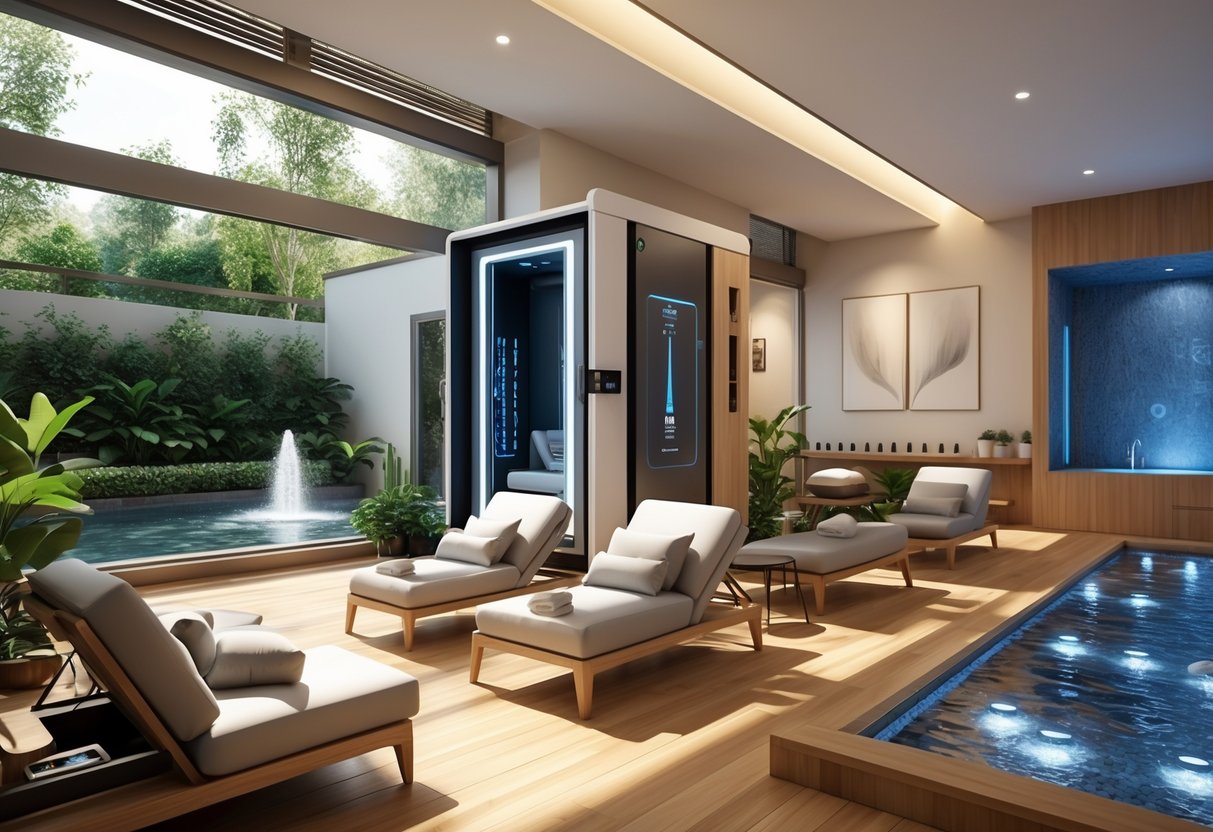
Esports facilities now feature wellness areas that rival traditional sports centers. These spaces help players stay in shape and bounce back from intense practice.
Cold Plunge Tubs and Hydrotherapy
Cold therapy is a staple in top esports venues. Players jump into cold plunge tubs to cut down inflammation after long training blocks.
Water usually sits at 10-15°C (50-59°F). Players spend three to five minutes in the tub, which gets blood flowing and helps recovery.
Many venues pair cold plunges with heated pools for contrast therapy.
| Equipment Type | Temperature | Session Duration | Primary Benefit |
|---|---|---|---|
| Cold Plunge | 10-15°C | 3-5 minutes | Reduces inflammation |
| Heated Pool | 37-40°C | 10-15 minutes | Muscle relaxation |
| Contrast Therapy | Alternating | 20-30 minutes total | Enhanced recovery |
Teams have noticed recovery times drop by 30%. Players report less muscle tension and sharper focus during their next practice session.
Dedicated Massage Rooms
Massage rooms are built for esports players. You’ll find adjustable tables and equipment made for gaming-related tension.
Special chairs target neck and shoulder pain. Some venues have percussion therapy devices for solo use.
Sports massage focuses on the neck, shoulders, wrists, and lower back—basically, the areas that take a beating during gaming.
Sessions run 45-60 minutes, usually during downtime or between scrims.
Some facilities go further with vibration therapy platforms that speed up muscle recovery.
Fitness and Conditioning Equipment
Modern esports gyms don’t just have basic weights. They focus on gear that supports gaming performance and helps prevent injuries.
Posture correction stations use resistance bands and alignment tools to fight the effects of long hours sitting.
Balance boards and stability gear build core strength, which supports better posture.
| Equipment Category | Primary Focus | Training Time |
|---|---|---|
| Posture Correction | Spine alignment | 15-20 minutes |
| Core Stability | Balance/strength | 20-30 minutes |
| Flexibility Training | Range of motion | 10-15 minutes |
Vibration platforms help stretch and warm up before tough sessions.
Recovery-focused gear keeps players in shape and lets them practice longer without getting worn out.
Living Quarters and Accommodation
Esports teams now offer modern housing so players can focus on the game. These places blend private spaces with shared areas for team bonding and practice.
Modern Apartment Units
Teams usually put players in furnished apartments close to the training center. Each player has a private bedroom with a gaming setup, but shares common spaces with just one or two others.
Standard amenities include:
- High-speed fiber internet for lag-free play
- Ergonomic chairs and adjustable desks
- Blackout curtains for sleep
- AC and heating controls
Most teams cover all bills—electricity, water, internet—the lot. Players can opt out if they want, but most stick with team housing during their contracts.
Since 2020, accommodation has gotten way better. Top teams offer hotel-style rooms with private bathrooms, while entry-level orgs make sure two players at most share a bathroom.
Spacious Common Areas
Shared living spaces matter for team chemistry. Kitchens, comfy seating, and entertainment setups let players hang out or review matches together.
Common facilities include:
- Kitchens with modern appliances
- Big dining tables for group meals
- Living rooms with multiple screens for film review
- Rec areas with consoles for downtime
Many teams bring in cleaning services, so players don’t have to worry about chores. Some even offer meal prep or cooking lessons to keep nutrition on track during tough training weeks.
The design balances privacy and togetherness. Players can chill in their rooms or join teammates in the common areas to keep the team vibe strong.
On-Site Staff Housing
Coaching staff and support teams usually stay right in the same complex or in buildings close by. This setup gives everyone 24/7 access during the intense lead-up to tournaments and helps the whole group really gel.
Staff accommodation usually covers:
- Head coaches and assistant coaches
- Analysts and data specialists
- Team managers and coordinators
- Mental health and fitness professionals
With staff on-site, teams can tackle problems the moment they pop up and keep communication flowing. Coaches get to answer gameplay questions during solo practice or jump in with feedback when something’s off.
Most successful organisations have adopted this living model. It’s a bit like traditional sports camps—everyone lives and works together, chasing the same big goals.
Family and Guest Facilities

Modern gaming venues know players often bring family and friends, and those guests need a decent place to hang out. These spaces make the experience better for non-players and honestly, they help venues draw in a wider crowd.
Family Lounges
Family lounges give parents, siblings, and friends a soft place to sit and relax while matches are on. You’ll usually find comfy chairs, plenty of charging outlets, and a good view of the action.
A well-designed family lounge offers free Wi-Fi, drinks, and quiet spots for calls. Most places throw in big screens showing the tournament, so families can keep up without being on the main floor.
The best lounges mix comfort with convenience. Easy access to toilets and snacks is key, and nobody wants to trek through the gaming area just to grab a coffee. Some venues even stock a few books or magazines for longer events.
Key features that work well:
- Comfy seating with power outlets
- Good views of gaming or broadcast screens
- Quiet spots for calls or work
- Quick access to refreshments and facilities
Private Restrooms for Visitors
Venues set up separate restrooms for visitors, keeping things clean and organised. These get a lot of use, so staff clean them often—way more than the player-only spaces.
Family-friendly restrooms come with baby changing tables and accessible features. Clear signs help people find their way without wandering into off-limits areas.
Most venues put these restrooms near lounges and main doors, not buried in the gaming section. That way, families can slip in and out without adding to the crowd around players.
Children’s Play Spaces
Kids get bored fast, so venues set up play areas to keep them busy during long matches. Safety comes first—expect soft play stuff, kid-friendly games, and tables for drawing or crafts.
The best children’s zones are close to family lounges so parents can keep an eye out. Surfaces are easy to wipe down, corners are rounded, and there’s something for every age group.
Popular play space elements:
- Gaming stations for kids
- Soft play equipment for little ones
- Art supplies and quiet activities
- Clear sightlines from family areas
Rules about supervision and age groups change depending on where you are, but most places require an adult to stick around.
Professional & Collaborative Spaces
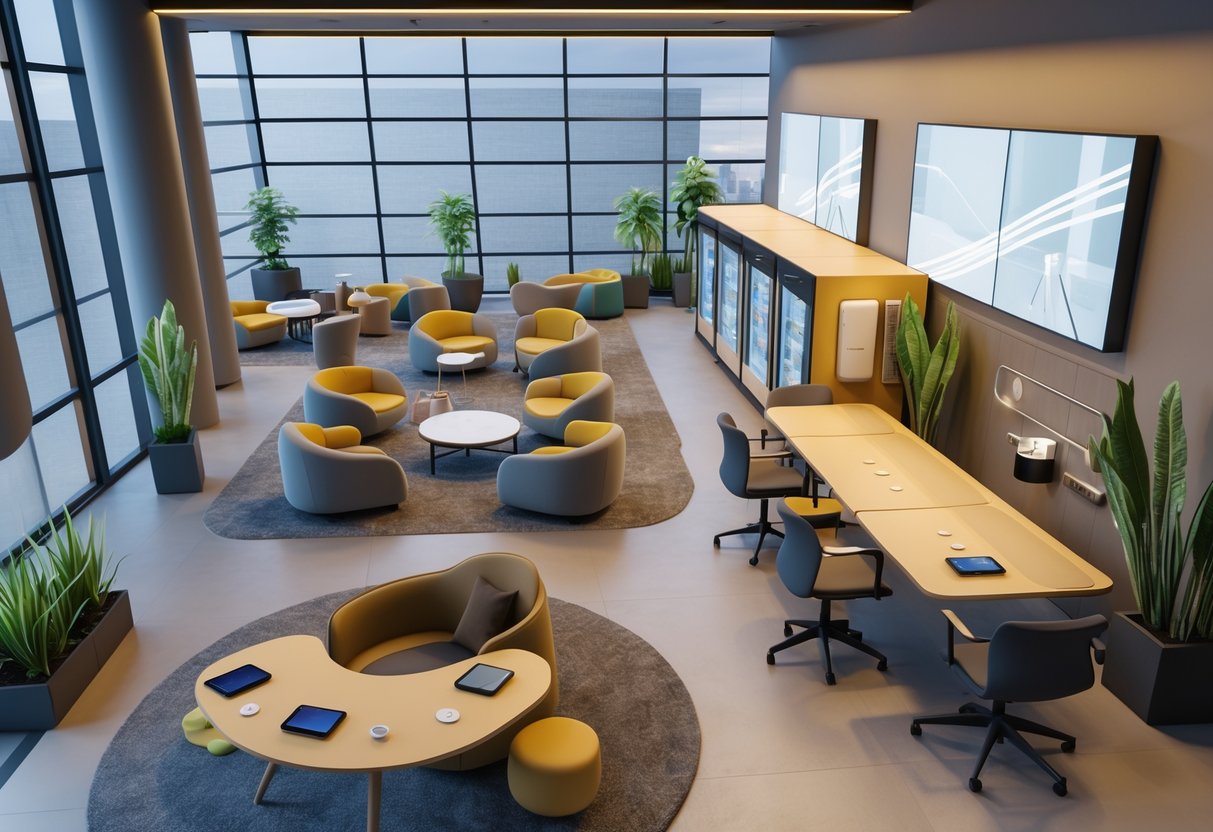
Top-tier training facilities always include spaces for teams to strategise, review games, and hold meetings. These rooms help players break down performance data, plan out tactics, and keep things professional.
Team Conference Rooms
Conference rooms act as the command center in any esports facility. Teams use them for pre-game talks, post-match breakdowns, and tactical meetings away from the noise.
Essential equipment includes:
- Big screens for watching match footage
- Whiteboards for strategy
- Video call tools for remote coaching
- Comfortable chairs for long sessions
The best conference rooms fit 8-10 people, so the whole team plus coaches and analysts can join in.
Soundproofing matters. Teams need to talk tactics in private, so facilities use thick doors and acoustic panels to keep things confidential.
Quick tip: Place conference rooms away from noisy gaming zones for better focus.
Meeting and Strategy Areas
Smaller meeting spots work well for coaches and individual players to chat privately. They’re perfect for reviews, contract talks, and one-on-one coaching.
Key features we recommend:
- Flexible seating
- Multiple monitors for game review
- Recording gear for training
- Adjustable lights for video calls
These rooms are cozy, usually for 2-4 people. The small setup makes it easier for players to open up about performance or personal stuff.
Storage solutions are a must. Teams need secure spots for strategy docs and contracts.
A lot of venues use movable walls to change room sizes as needed. That way, they can adapt on the fly.
Classroom Facilities
Esports keeps getting more academic, so facilities add rooms for theory, analysis, and skill-building workshops.
Standard classroom setup includes:
- Tiered seats for better views
- Projectors for lessons
- Workstations with computers
- Recording gear for classes
Classrooms typically fit 15-30 people. That covers academy squads, coaching clinics, or even community events.
Interactive tech makes learning stick. Smart boards and collaborative apps keep things lively during theory sessions.
Teams often use these rooms for making educational content or running fan meetups.
Practical consideration: Good Wi-Fi is non-negotiable—video calls, streaming, and cloud tools all depend on it.
Leisure and Recreational Features
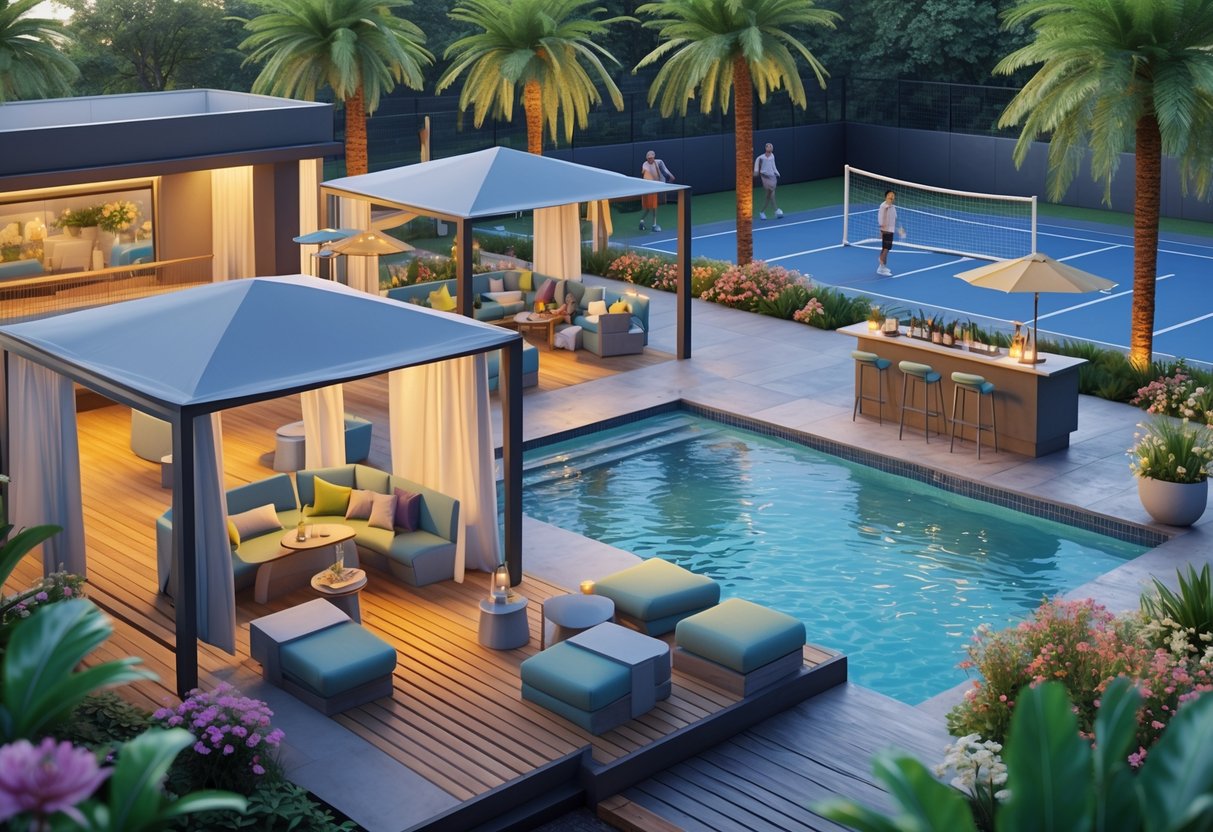
Modern gaming venues don’t just focus on training—they carve out space for players to relax and hang out. Whether you’re into game rooms or prefer the outdoors, there’s usually something for every mood.
Games Rooms
A good games room really pulls people together. Over time, these spaces have grown from basic lounges to full-blown entertainment hubs.
Essential Equipment
- Pool and table tennis
- Console gaming stations
- Board and card games
- Cozy seating for groups
Facilities try to offer both competitive and chill options. Pool tables always seem to be a hit—players get a break from screens but still keep that competitive edge.
Layout Considerations The best setups separate noisy games from quiet ones. Board games in one corner, pool in another—no one gets interrupted.
Retro arcade machines and classic consoles are making a comeback too. They add a fun, nostalgic vibe that everyone seems to appreciate.
Quick win: Try out different games during quieter hours to find your go-to way to unwind.
Outdoor Patio Spaces
You can’t beat a bit of fresh air after hours at a screen. Outdoor spaces have become a must-have for esports facilities.
Design Features
- Weatherproof seats with power outlets
- Wi-Fi everywhere, even outside
- Covered spots for rain or sun
- Quiet corners for calls or meetings
Teams often hold meetings out here. The change of scene can spark new ideas or help break a mental block.
Seasonal Adaptations British weather isn’t always kind, so venues use awnings, heaters, and windbreaks to keep patios usable year-round.
Some places even set up outdoor gaming with weatherproof gear. Big screens for tournament streams make for epic viewing parties.
Networking Benefits Patios naturally get people talking. It’s where you’ll see players and staff from different teams mixing and sharing tips.
Pool and Barbecue Areas
Swimming pools and barbecues turn a venue into more than just a place to play—they make it a hangout spot.
Pool Facilities
- Heated pools for all seasons
- Shaded poolside seating
- Changing rooms and towels
- Safety gear and clear rules
Swimming is great low-impact exercise for gamers. Many pros use pool time for recovery and stress relief.
Barbecue and Dining Spaces Outdoor grills let teams celebrate together. Gas barbecues are easy to use and still keep that social vibe.
Event Hosting These spaces are perfect for afterparties or team get-togethers. The laid-back atmosphere helps everyone relax after big matches.
Practical Considerations
- Bookings keep things from getting too crowded
- Regular maintenance keeps everything working
- Plans in place for bad weather
- Menu options for all diets
Warning: Always keep an eye on pool areas, especially after dark—safety first.
Personal Services
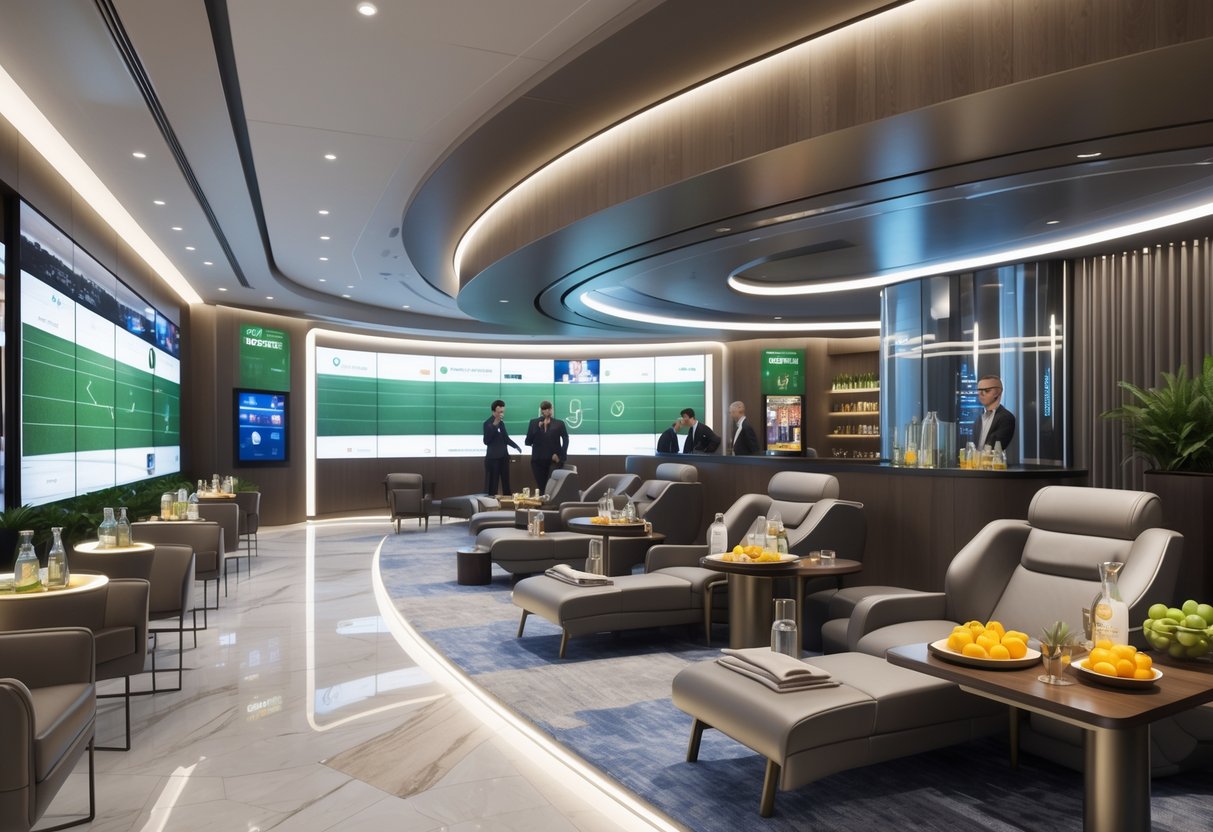
Pro athletes get a lot of personal services to take daily chores off their plate. This lets them focus on their game, not laundry or booking appointments. Services range from grooming to full-on lifestyle management.
On-Site Barbershops
These days, most pro facilities have their own barbershops. We’re not talking quick trims—these are proper salons with stylists who get what athletes need.
Services typically include:
- Haircuts and styling
- Beard trims and shaves
- Skincare
- Hair washing and conditioning
A lot of venues team up with top grooming brands. Players often get free products and treatments during the season.
The convenience is unbeatable. Athletes can swing by for a cut between scrims or before a press event—no need to book across town.
Some places even send stylists to hotel rooms during away matches. Handy, right?
Laundry and Dry Cleaning
Laundry services here are next level. They handle everything from sweaty kits to dress clothes, and esports players go through a lot of gear.
Standard services cover:
- Same-day cleaning and pressing
- Special care for technical fabrics
- Stain removal and minor repairs
- Pickup and drop-off at lockers or rooms
Premium facilities use machines that treat expensive clothes gently. They know how to keep high-tech fabrics in good shape.
Family members can use the same laundry system, which is a nice bonus.
When teams travel, laundry services coordinate with hotels so clean clothes are ready on arrival. Dirty stuff gets collected without any hassle.
Concierge Assistance
Concierge teams handle all the fiddly life admin so players don’t have to. They go way beyond just booking restaurants.
Core services include:
- Restaurant reservations
- Travel planning and booking
- Event ticket sourcing
- Personal shopping
Tech-savvy concierges are especially helpful for gamers. They sort out gear, streaming setups, and even arrange sponsor deliveries.
The best teams have contacts everywhere and can score VIP access that’s tough to get otherwise.
If there’s an emergency, concierges jump on it straight away—no waiting around.
Family and close friends often benefit too, making sure everyone in the circle gets looked after.
Transportation and Access
Pro players rely on dedicated transport services that take the hassle out of travel and get them where they need to be on time. Exclusive parking and free rides to matches or training are all part of the package.
Reserved Parking for Players
Players get their own parking spaces right next to venue entrances. You’ll spot these clearly marked spots—usually covered to keep cars safe from the weather.
Key benefits include:
- Direct access to player entrances
- 24/7 security watching over the area
- Weather protection for vehicles
- No hunting for spaces on match days
Most venues place these spaces within 50 metres of player facilities. Security staff keep a close eye on these areas during events and training.
Typical features we see:
- Each player gets an assigned space
- Spaces are wider for bigger vehicles
- Charging stations for electric cars
- Private gates with keycard access
These parking spots usually connect straight to secure paths leading to the changing rooms. Players can skip public areas entirely when they arrive for matches.
Complimentary Courtesy Cars
Teams offer free transport for players who need another way to get around. You’ll often see pro drivers behind the wheel of premium vehicles, ready for any occasion.
Common scenarios include:
- Airport rides for away games
- Trips to team events or media days
- Emergency rides for injured players
- Lifts to training facilities
They usually use luxury sedans or SUVs with tinted windows for privacy. Teams choose drivers who’ve passed security checks and know how to keep things discreet.
Service details:
- Available 24/7 if something urgent pops up
- Book ahead for scheduled trips
- Teams handle the billing directly
- GPS tracking keeps things safe and efficient
Some clubs team up with high-end transport companies to run this service. Others just keep their own fleet of cars for players.
Players can book these rides through team apps or a dedicated phone line. Most get a response in under 30 minutes for regular requests, and instantly if it’s an emergency.
Design Innovation and Accessibility
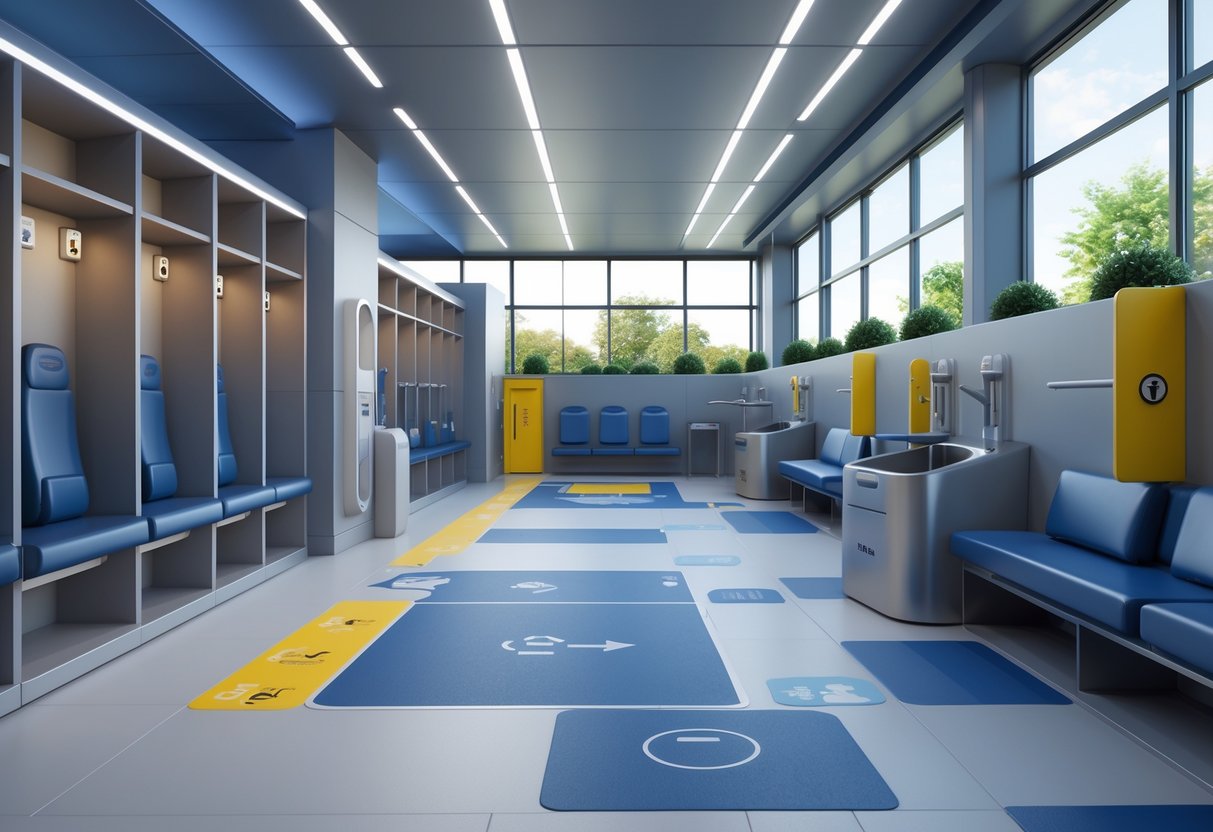
Modern esports facilities are shaking things up with ergonomic design and custom furniture. The goal? Make sure pros can train and compete at their best, without sacrificing comfort or health during those long gaming marathons.
Ergonomics for Athlete Comfort
Pro esports athletes often spend more than 12 hours a day in training rooms. Bad ergonomics can cause repetitive strain injuries and cut careers short.
Key ergonomic features now include adjustable monitor arms to reduce neck strain and keep screens at the right height. Gaming chairs come with lumbar support, built just for those marathon sessions.
Temperature control matters more than you’d think. Today’s players lounges let each athlete tweak their own climate zone, so nobody overheats during intense practice.
Lighting systems use circadian rhythm technology to support natural sleep cycles. Blue light filters adjust automatically, helping with eye strain and keeping focus sharp late into the night.
Custom Furnishings for Professional Players
Bespoke furniture helps with the unique needs of competitive gamers. Height-adjustable desks fit any setup, whether it’s a single monitor or a wall of screens.
Modular seating systems let teams rearrange rooms easily, flipping between solo practice and group strategy. These designs hide cables, cutting down on clutter and trip hazards.
Workstations have built-in storage for gear and team materials. Anti-vibration mounts keep desks steady during high-stakes play, which is crucial for games like CS2 or Valorant.
Designers add acoustic panels to furniture, cutting noise in shared training spaces. Players communicate better during team drills and don’t get distracted by nearby chatter.
Security and Privacy
Gaming platforms now protect player data with encryption and secure payment systems. These tools help keep personal info out of hackers’ hands.
Most esports platforms use two-factor authentication (2FA). That extra step really helps if someone tries to steal your password.
Key Security Features
| Security Method | What It Does | Why It Matters |
|---|---|---|
| Encryption | Scrambles your data | Keeps info private during transfers |
| Secure Payment | Protects card details | Safe money transactions |
| 2FA | Extra login step | Stops account takeovers |
Warning: Always make sure platforms have valid security certificates before you share any personal details.
Gaming companies now talk directly with players to improve safety. They ask for feedback and fix security issues fast.
Privacy policies have gotten easier to understand. We can actually see what data companies collect and what they do with it.
Cross-platform gaming brings new headaches. Your data jumps between devices and services, but good platforms protect it everywhere.
Quick win: Turn on 2FA on all your accounts. It takes just a couple of minutes and blocks most hacks.
Age verification systems now protect younger players. These check ages but don’t store extra personal info.
Teams run regular security audits to look for weak spots. They fix problems before hackers can find them.
Modern platforms use blockchain technology for secure, transparent transactions—without exposing player identities.
Frequently Asked Questions
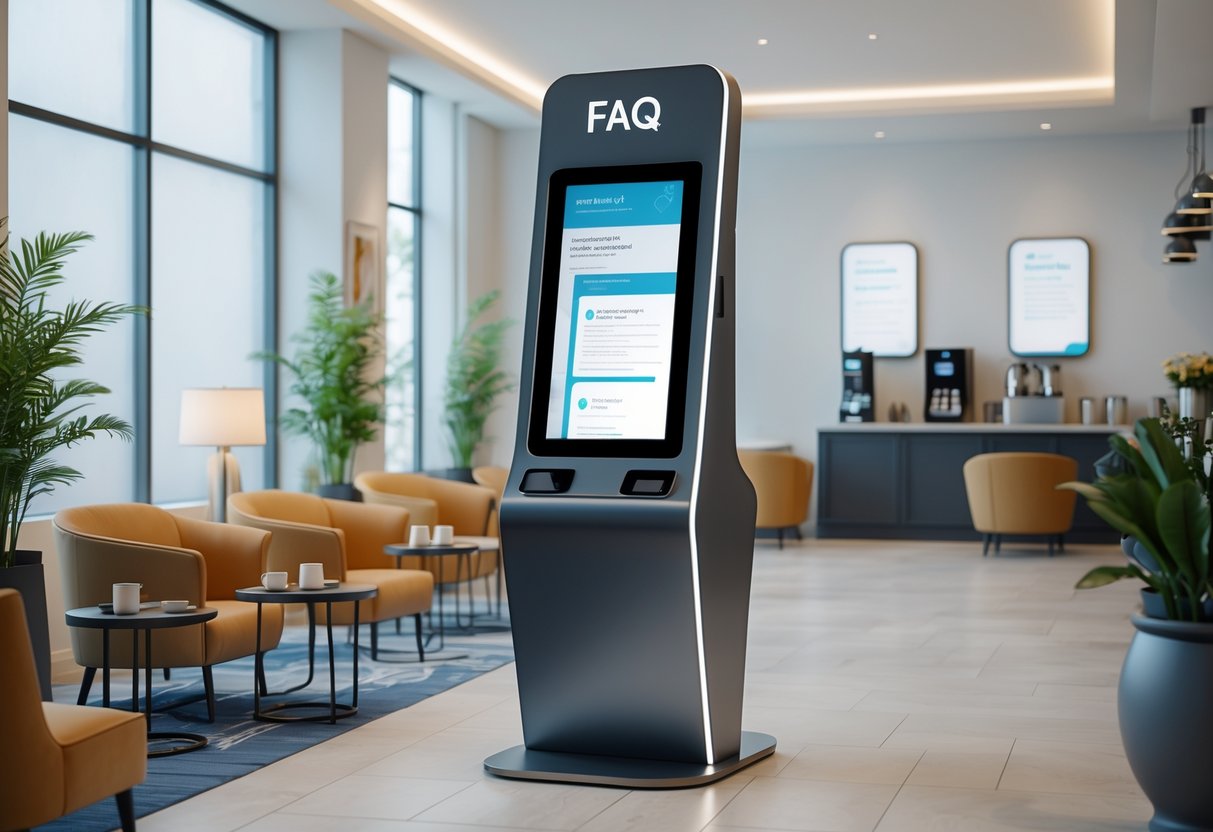
The NFLPA player survey gives us a pretty honest look at which teams treat their players right and which ones… well, don’t. Recent report cards show some teams really shine, while others are still lagging behind.
What are the top-rated facilities in the NFL as voted on by the players?
The Cincinnati Bengals usually land near the top in NFLPA surveys. Their training complex gets high marks for its weight room, locker rooms, and food.
Players also love the Las Vegas Raiders’ setup. Their Henderson facility has excellent recovery areas and all the latest equipment.
The Miami Dolphins have poured money into upgrades. Players call out their training rooms and recovery amenities as standouts.
How do the latest NFLPA team report cards compare across the league?
The 2024 NFLPA report cards show a big spread between the best and worst. Teams get grades from A+ to F in eight categories, like training and weight rooms.
Several teams scored A’s in more than one category. The best ones clearly invest in modern gear and player comforts.
Teams with lower grades usually have older facilities. A lot of them get D’s or F’s for food and travel.
Can you share the highlights from the most recent NFL player survey findings?
The latest survey says 15 teams earned C+ or better overall. That’s a step up from previous years—more teams are upgrading their facilities.
Food service still needs work. Lots of teams get low marks for meal quality and nutrition.
Recovery amenities are improving the fastest. Teams are adding things like cold tubs, saunas, and sleep pods to help with recovery.
Which team received the highest grade on the NFLPA report card this year?
The Cincinnati Bengals grabbed the top spot this year. They got A+ ratings for training facilities and strength coaching.
Their high grade comes from recent upgrades and big investments in equipment and space.
They also stand out in player development resources. The Bengals provide lots of support staff and the latest recovery tech.
What criteria are used by the NFLPA to evaluate team facilities and amenities?
The NFLPA looks at eight main areas in their survey. These include training rooms, weight rooms, locker amenities, and food service.
Players also rate travel and family room facilities. The survey covers both home and away game experiences.
Each area gets a letter grade from A+ to F. The overall grade averages out the team’s performance in all areas.
Have there been significant improvements in player amenities as indicated in the NFLPA report cards over the past few years?
Facility standards across the league have definitely gotten better in recent years. More teams actually earn passing grades now, which wasn’t always the case.
Teams have focused a lot on technology and recovery amenities. You’ll notice more sleep monitoring, cryotherapy, and upgraded training gear popping up.
Still, not everything’s perfect. Food service and travel are two areas where a lot of franchises just can’t seem to get it right, even with all the other progress.

